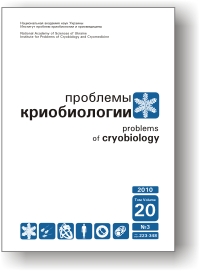Динаміка Ð·Ð°Ð³Ð¾Ñ”Ð½Ð½Ñ Ñ…Ð¾Ð»Ð¾Ð´Ð¾Ð²Ð¸Ñ… ран шкіри, рівень перокÑидації ліпідів та лейкоцитарний профіль крові щурів на фоні Ð²Ð²ÐµÐ´ÐµÐ½Ð½Ñ ÐµÐºÑтрактів тваринного походженнÑ
Ключові слова:
холодова рана, загоєннÑ, екÑтракт Ñелезінки, екÑтракт підмору бджілАнотація
ДоÑліджено вплив екÑтракту кріоконÑервованих фрагментів Ñелезінки Ñвиней (ЕСС) Ñ– екÑтракту підмору бджіл (ЕПБ) на динаміку Ð·Ð°Ð³Ð¾Ñ”Ð½Ð½Ñ Ñ…Ð¾Ð»Ð¾Ð´Ð¾Ð²Ð¸Ñ… ран шкіри, рівень ПОЛ та показники крові щурів лінії Ð’Ñ–Ñтар Ñ– СфінкÑ. Ð’Ñтановлено, що холодові рани у щурів Ð¡Ñ„Ñ–Ð½ÐºÑ Ð·Ð°Ð³Ð¾ÑŽÑŽÑ‚ÑŒÑÑ Ð¿Ð¾Ð²Ñ–Ð»ÑŒÐ½Ñ–ÑˆÐµ, ніж у щурів лінії Ð’Ñ–Ñтар. Ð£Ð²ÐµÐ´ÐµÐ½Ð½Ñ Ð•Ð¡Ð¡ або ЕПБ приÑкорює Ð·Ð°Ð³Ð¾Ñ”Ð½Ð½Ñ Ñ€Ð°Ð½, нормалізує показники крові та знижує рівень перокÑидації ліпідів. ЕкÑтракт Ñелезінки має більшу біологічну активніÑÑ‚ÑŒ, ніж екÑтракт бджіл.
Downloads
Опубліковано
Як цитувати
Номер
Розділ
Ліцензія
Авторське право (c) 2020 A. V. Shinder, S. Ye. Galchenko, L. V. Ostankova, O. P. Synchykova

Ця робота ліцензується відповідно до Creative Commons Attribution 4.0 International License.
Автори, які публікуються у цьому журналі, погоджуються з наступними умовами:
- Автори залишають за собою право на авторство своєї роботи та передають журналу право першої публікації цієї роботи на умовах ліцензії Creative Commons Attribution License, котра дозволяє іншим особам вільно розповсюджувати опубліковану роботу з обов'язковим посиланням на авторів оригінальної роботи та першу публікацію роботи у цьому журналі.
- Автори мають право укладати самостійні додаткові угоди щодо неексклюзивного розповсюдження роботи у тому вигляді, в якому вона була опублікована цим журналом (наприклад, розміщувати роботу в електронному сховищі установи або публікувати у складі монографії), за умови збереження посилання на першу публікацію роботи у цьому журналі.
- Політика журналу дозволяє і заохочує розміщення авторами в мережі Інтернет (наприклад, у сховищах установ або на особистих веб-сайтах) рукопису роботи, як до подання цього рукопису до редакції, так і під час його редакційного опрацювання, оскільки це сприяє виникненню продуктивної наукової дискусії та позитивно позначається на оперативності та динаміці цитування опублікованої роботи (див. The Effect of Open Access).




